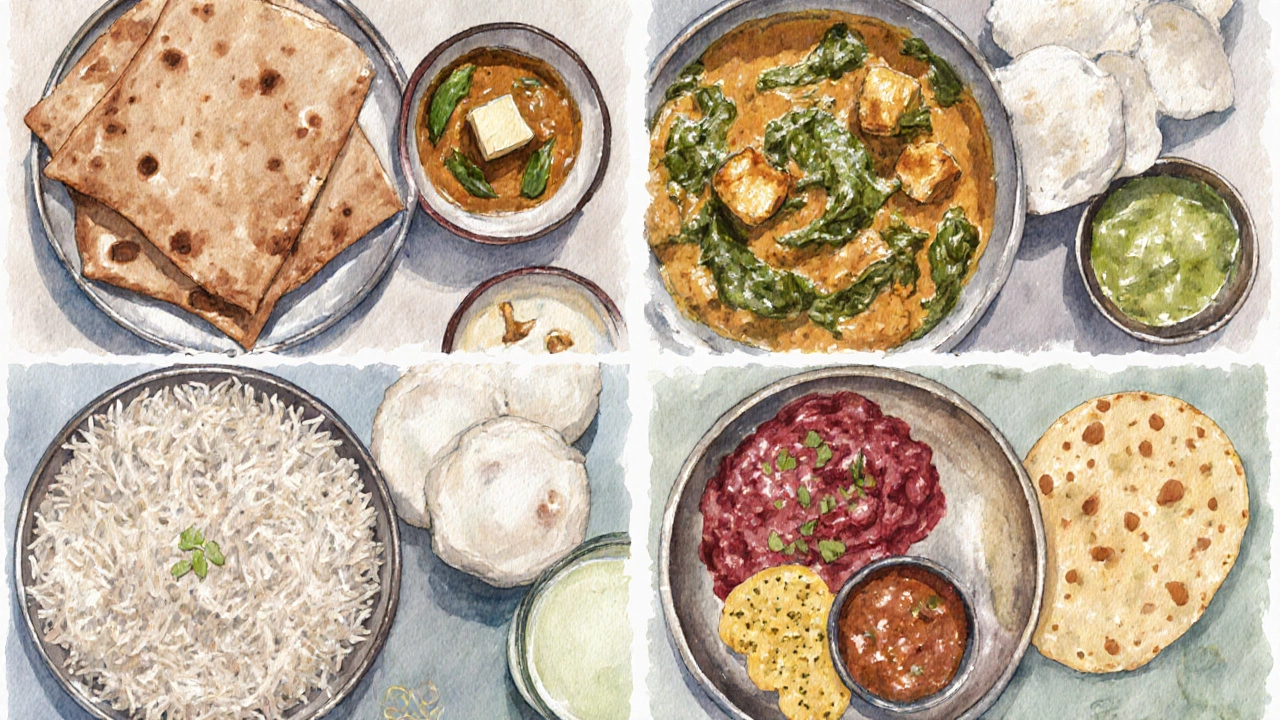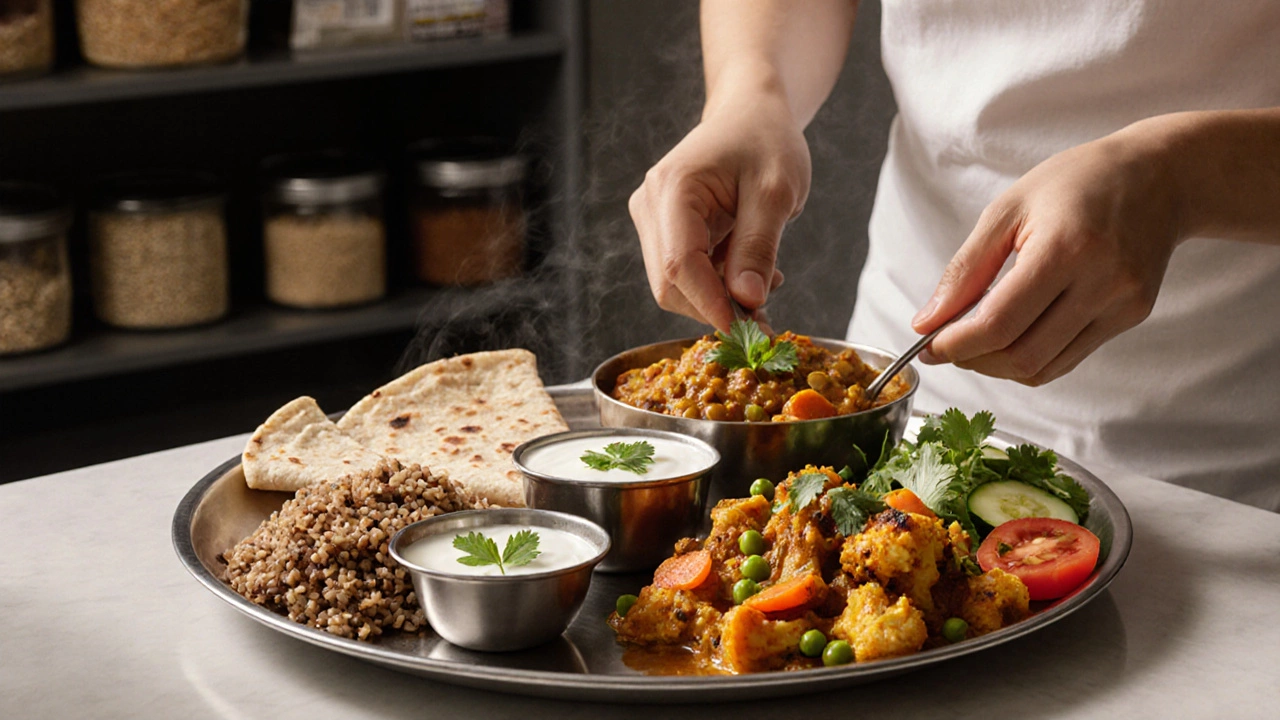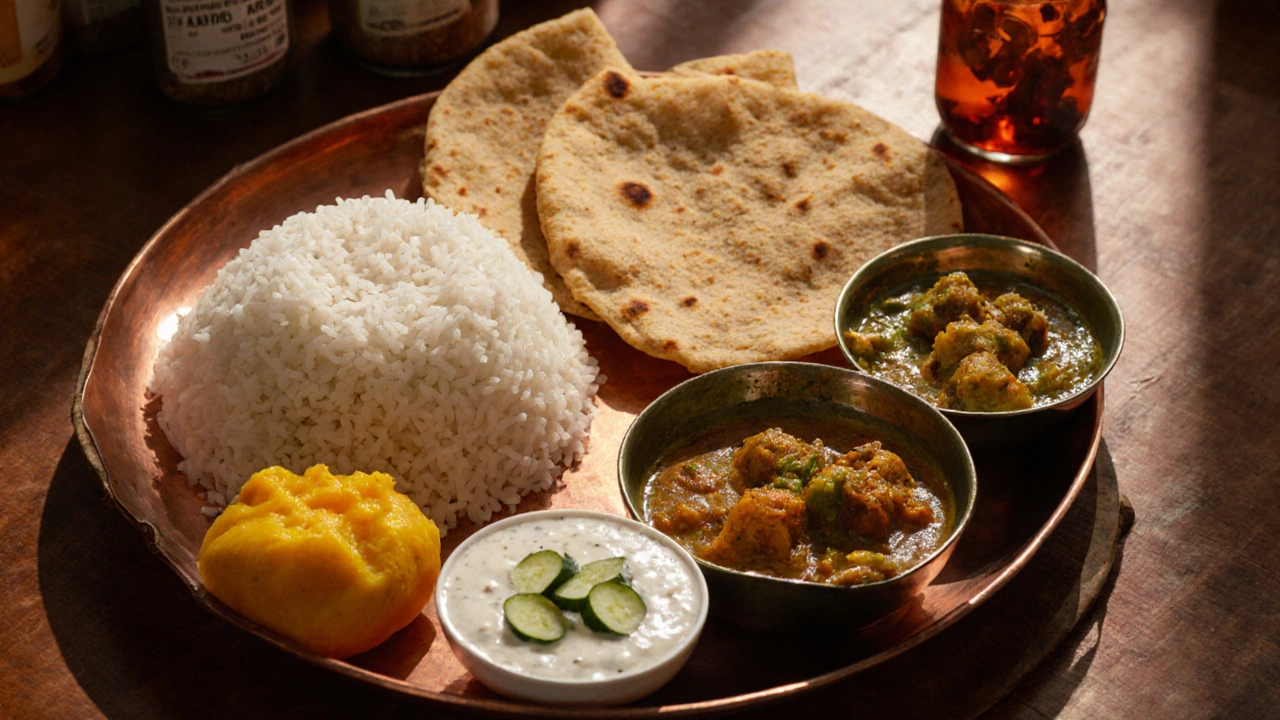Indian Vegetarian Meal Builder
Staple Component
Protein Source
Vegetable Curry
Dairy or Side
Your Custom Thali
Tip: Try combining components from different regions for a unique flavor profile!
Meal Components Breakdown
| Component | Selection | Nutritional Benefit |
|---|---|---|
| Staple | - | Provides complex carbohydrates for sustained energy |
| Protein | - | Supports muscle repair and satiety |
| Vegetable | - | Rich in fiber, vitamins, and antioxidants |
| Dairy/Side | - | Provides probiotics and calcium |
When you hear the term Indian vegetarian meal is a plant‑based dining experience that brings together a balance of grains, legumes, vegetables, dairy, and flavorful condiments on a single plate. It’s not just a single dish; it’s a collection of dishes arranged to satisfy taste, texture, and nutrition in every bite. Think of a colorful spread where each element plays a role-some provide protein, others carbs, and a few add that zing you crave.
Key Takeaways
- Typical Indian vegetarian meals revolve around a staple (rice or flatbread), a protein‑rich dal, a vegetable curry, and at least one dairy or yogurt side.
- Regional variations dictate the type of flatbread, spice level, and accompanying pickles or chutneys.
- The meal aims for a nutritional balance: carbs, protein, fiber, and healthy fats.
- Assembling a “thali” makes the meal visually appealing and easy to portion.
- Simple swaps (e.g., brown rice, whole‑wheat roti) keep the traditional experience health‑friendly.
Core Components of a Classic Plate
While the exact lineup changes by region, most Indian vegetarian meals share four pillars:
- Staple carbohydrate - either steamed rice (long‑grain basmati or short‑grain varieties, often cooked with a pinch of cumin) or a flatbread like chapati (whole‑wheat unleavened bread cooked on a hot tawa).
- Protein source - most commonly dal (lentils, split peas, or beans simmered with spices). Popular varieties include toor dal, moong dal, and masoor dal.
- Vegetable curry - a seasonal mix like aloo gobi (potato‑cauliflower curry flavored with turmeric and cumin) or bhindi masala (okra cooked with onion, tomato, and mustard seeds).
- Dairy or cooling side - typically raita (yogurt mixed with cucumber, carrot, or spices) or a simple bowl of plain curd.
Accompaniments such as pickles (achar) or chutneys (coriander‑mint chutney) add acidity and brightness.
Regional Flavors and Their Signature Items
India’s sheer size means each state has turned the basic template into something uniquely its own.
| Region | Staple | Protein | Vegetable Highlight | Typical Accompaniment |
|---|---|---|---|---|
| North (Punjab, Delhi) | Whole‑wheat roti | Dal makhani (black lentils in buttery gravy) | Saag paneer (spinach with cottage cheese) | Butter, mango achar |
| South (Tamil Nadu, Karnataka) | Steamed rice or idli | Toor dal (sambar style) | Undhiyu (mixed veg medley) or avial | Coconut chutney, pickle |
| West (Gujarat, Maharashtra) | Flatbreads like thepla or bhakri | Urad dal (fried) | Ringro (spiced beetroot) or bharli vangi | Sweet lassi, dry mango powder (amchur) |
| East (Bengal, Odisha) | Steamed rice | Masoor dal (red lentil) | Shukto (bitter‑sweet veg stew) | Mustard pappad, tamarind chutney |

Building a Balanced Thali
‘Thali’ simply means a round metal plate, but in everyday talk it represents the whole spread. Follow these steps to assemble a nutritionally complete thali:
- Start with a base of rice (½ plate) or roti (2‑3 pieces).
- Add a generous scoop of dal (¼ plate) for protein and fiber.
- Place a serving of vegetable curry next to the dal (¼ plate).
- Include a small bowl of raita or plain yogurt (a spoonful) to cool the palate.
- Finish with a splash of pickle or chutney for acidity.
- If you like, sprinkle a spoonful of ghee over the dal for extra flavor and healthy fats.
Visually, the thali should look colorful-greens from the veg, reds from tomato‑based curries, yellows from turmeric‑spiced dal, and whites from yogurt. That visual cue often mirrors a well‑balanced nutritional profile.
Health Benefits and Smart Swaps
Indian vegetarian meals naturally provide:
- Complex carbs from rice or whole‑grain breads, giving sustained energy.
- Plant protein from lentils, beans, and paneer, supporting muscle repair.
- Fiber from vegetables and pulses, aiding digestion.
- Probiotics from yogurt, which help gut health.
- Micronutrients like iron (spinach, lentils), calcium (paneer, yogurt), and vitaminC (tomatoes, lemon juice).
If you’re watching calories, try these swaps:
- Choose brown basmati or quinoa instead of white rice.
- Opt for whole‑wheat or millet rotis rather than refined flour (maida) versions.
- Use low‑fat paneer or tofu for a lighter protein source.
- Limit ghee to a teaspoon per serving; olive oil works as a heart‑friendly alternative.
Common Mistakes and How to Avoid Them
Even seasoned cooks slip up. Here are the usual pitfalls:
- Over‑spicing - Adding too many whole spices can mask the natural flavors of the vegetables. Start with a tempered tsp of mustard seeds, then taste before adding more.
- Undercooking dal - Lentils should be soft enough to mash with a spoon. Soak them for 30minutes before cooking to reduce time.
- Skipping the tempering (tadka) - A quick hot‑oil toss of cumin, garlic, and dried red chilies adds depth. Skipping it leaves the dal flat.
- One‑pot monotony - A thali should have contrasting textures. Pair a creamy dal with a crisp papad or roasted papadums.

Quick Recipes to Get You Started
Below are two starter recipes that cover the essential pillars.
Simple Tadka Dal (1cup dry lentils)
- Rinse 1cup toor dal; soak 20minutes.
- Cook with 3cups water, a pinch turmeric, and a pinch salt until soft (≈20min on medium).
- In a separate pan, heat 1tbsp oil, add ½tsp mustard seeds, ½tsp cumin seeds, 2 sliced green chilies, and a pinch asafoetida.
- Once the seeds crackle, pour the hot tadka over the cooked dal, stir, and garnish with fresh coriander.
Quick Mixed Veg Curry (serves 2)
- Chop 1cup cauliflower, 1cup carrots, and ½cup peas.
- Sauté 1tbsp oil, add ½tsp cumin seeds, ½tsp ginger‑garlic paste, then the veggies.
- Add 1tsp tomato puree, ½tsp garam masala, ¼tsp turmeric, and ½cup water. Cover and simmer 10min.
- Finish with a splash of lemon juice and fresh cilantro.
Next Steps for the Curious Cook
If you enjoyed the basics, try exploring:
- Regional thali challenges - cook a full North Indian thali one week, then a South Indian one the next.
- Seasonal veg swaps - replace cauliflower with pumpkin in autumn, or with bitter gourd in summer.
- Fusion twists - serve dal over quinoa, or use naan instead of roti for a Western‑Indian blend.
Frequently Asked Questions
What defines a meal as “Indian vegetarian”?
An Indian vegetarian meal excludes meat, fish, and eggs but can include dairy (paneer, yogurt), plant‑based proteins (dal, legumes, tofu), grains, and a variety of vegetables, all seasoned with Indian spices.
Can I make an Indian vegetarian meal without any dairy?
Absolutely. Substitute paneer with tofu or tempeh, use coconut yogurt instead of dairy yogurt, and rely on dal for protein. The flavors stay authentic as long as the spice mix is preserved.
How much spice is too much?
Start with the basic whole‑spice tempering (1tsp each of cumin and mustard seeds). Add ground spices in ¼‑tsp increments, tasting as you go. If the dish feels overpowering, balance it with a spoonful of yogurt or a splash of lemon juice.
Is a thali portion-controlled?
A traditional thali is naturally portioned: the staple occupies about ½ the plate, dal and veg each take a quarter, and the yogurt/pickle are just a spoonful. This built‑in balance helps moderate calorie intake.
Can I prepare the components ahead of time?
Yes. Cook the dal and rice a day before; store in the fridge. Vegetables can be pre‑chopped and kept in airtight containers. Reheat gently and add fresh tempering right before serving for the best aroma.
